Jewelry Layering 101: A Step-by-Step Guide

Jewelry layering has become a staple in current fashion trends, allowing individuals to express their personal style with elegance and sophistication. Mastering the art of layering jewelry can elevate any outfit, making it a valuable skill for anyone looking to stay on-trend.
We will guide you through the basics and advanced techniques of layering jewelry, providing a step-by-step approach to achieving stylish and on-trend looks. By understanding the principles of jewelry layering, you can create a unique and personalized style that reflects your individuality.
Key Takeaways
- Understand the basics of jewelry layering
- Learn advanced techniques for layering jewelry
- Create a personalized style with layered jewelry
- Stay on-trend with the latest jewelry layering tips
- Elevate your outfits with mastered layering skills
The Art of Jewelry Layering: Why It Matters
Jewelry layering is more than just a trend; it’s a means of self-expression and personal style evolution. By combining different pieces, individuals can create a look that is both unique and captivating.
Expression of Personal Style
Layering jewelry allows individuals to express their personal style in a nuanced and multifaceted way. It enables the mixing and matching of different textures, metals, and gemstones, creating a look that is distinctly personal.
By incorporating various elements, such as delicate chains, statement pieces, and symbolic tokens, individuals can tell a story through their jewelry, making their style more relatable and authentic.
Creating Visual Interest and Dimension
One of the key benefits of jewelry layering is its ability to add depth and visual interest to an outfit. By stacking necklaces, stacking rings, or combining different types of bracelets, individuals can create a visually appealing look that draws attention.
This technique not only enhances the overall aesthetic but also allows for the incorporation of different materials and textures, further enriching the visual experience.
Maximizing Your Jewelry Collection
Layering jewelry is an effective way to maximize one’s collection, making it more versatile and dynamic. By combining pieces in new and innovative ways, individuals can breathe new life into their existing jewelry, reducing the need for frequent purchases.
This approach also encourages creativity and experimentation, allowing individuals to discover fresh combinations that reflect their evolving style and preferences.
Essential Jewelry Pieces for Successful Layering
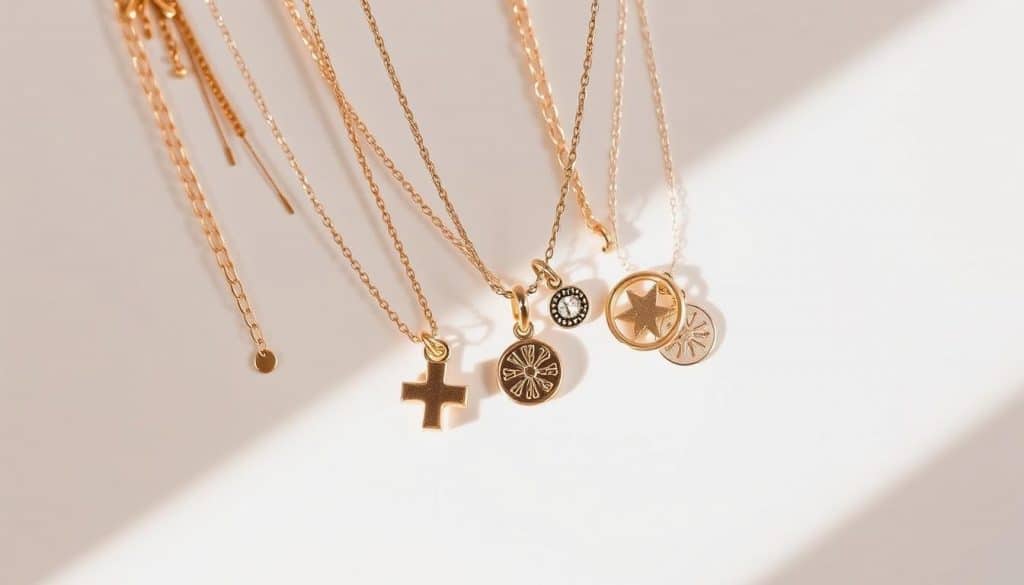
Successful layering begins with a solid foundation of essential jewelry items. To create a look that is both stylish and harmonious, it’s crucial to understand which pieces work well together.
Foundation Pieces Every Collection Needs
Every jewelry collection should have a set of foundational pieces that can be mixed and matched to create various layered looks. These include:
- Delicate Chain Necklaces: Perfect for layering, these necklaces come in various lengths and can be worn alone or with pendants.
- Simple Bangles: Bangles are versatile and can be stacked with other bracelets or worn solo.
- Midi Rings: These rings add a touch of elegance and can be stacked on multiple fingers.
Statement vs. Subtle Pieces
Balancing statement and subtle pieces is key to successful layering. Statement pieces draw attention and can be the focal point of your layered look, while subtle pieces add depth without overpowering the overall design.
- Statement Pieces: Bold necklaces, chunky bracelets, or oversized rings that command attention.
- Subtle Pieces: Delicate chains, thin bangles, or simple stud earrings that complement without overwhelming.
Quality Considerations for Layered Wear
When layering jewelry, quality is paramount. High-quality pieces not only last longer but also maintain their appearance over time. Consider the following:
- Material: Opt for durable materials like gold, silver, or platinum that can withstand daily wear.
- Craftsmanship: Look for pieces with intricate details and precise craftsmanship.
- Comfort: Ensure that the pieces are comfortable to wear, especially when layered.
By focusing on these essential elements, you can create a layered jewelry look that is both stylish and sophisticated.
Understanding Proportions and Balance
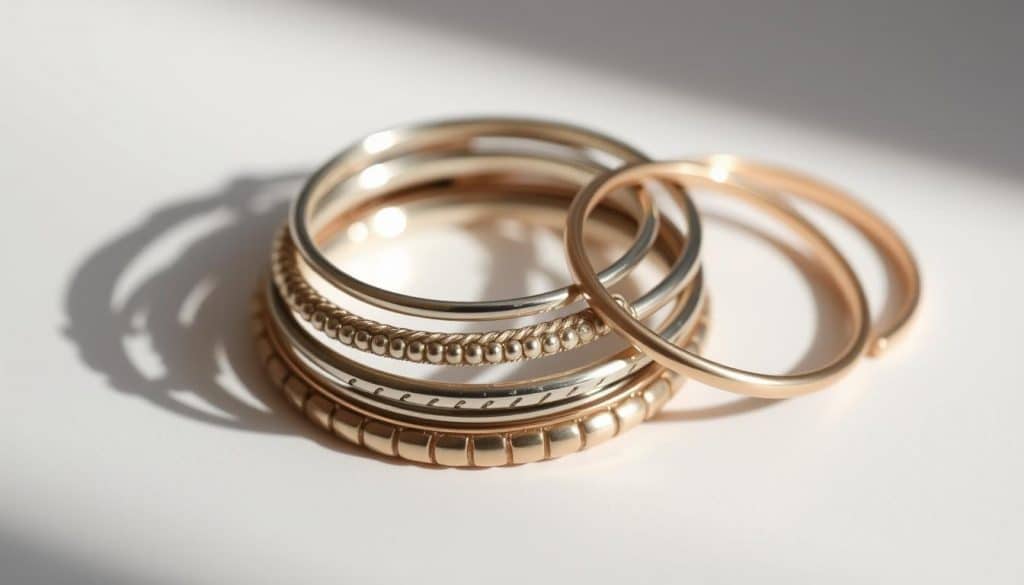
The key to successful jewelry layering lies in mastering the principles of proportion and balance. When done correctly, layered jewelry can elevate an outfit and make a bold fashion statement.
The Rule of Thirds in Jewelry Design
Applying the rule of thirds to jewelry layering involves dividing your layered pieces into thirds, both horizontally and vertically, and placing your focal points along those lines or at their intersections. This technique helps in creating a balanced and visually appealing arrangement.
For instance, when layering necklaces, you can use the rule of thirds to determine the optimal lengths and placement of your necklaces. A shorter necklace can be worn closer to the neck, while a longer one can be placed lower, creating a staggered effect that adheres to the rule of thirds.
Creating Visual Harmony
Visual harmony in jewelry layering is achieved by balancing different elements such as texture, color, and size. Mixing different textures, like smooth and rough, or combining various metals and colors, can add depth to your layered look.
To create visual harmony, consider the following:
- Mixing metals and textures to add depth
- Balancing bold pieces with simpler ones
- Using a unifying element, like a common color or theme, to tie different pieces together
Balancing Weight and Visual Impact
The weight and visual impact of jewelry pieces also play a crucial role in achieving balance. Heavier or more visually striking pieces should be balanced with lighter or simpler ones to prevent overwhelming the overall look.
| Jewelry Type | Weight/Visual Impact | Balancing Tip |
|---|---|---|
| Statement Necklace | High | Pair with simpler earrings or rings |
| Delicate Chain Necklace | Low | Layer with other delicate pieces or a bold cuff |
| Oversized Earrings | High | Balance with a simpler necklace or no necklace at all |
By understanding and applying these principles, you can master the art of jewelry layering and create looks that are both stylish and balanced.
How to Layer Jewelry: The Fundamental Techniques

The key to successful jewelry layering lies in applying a few simple yet effective techniques. We guide you through the process, ensuring that you can create stylish and harmonious combinations that elevate your look.
Step 1: Selecting a Theme or Story
When layering jewelry, the first step is to decide on a theme or story you want to tell through your accessories. This could be based on a particular metal type, gemstone, or style era. Having a unifying element helps in creating a cohesive look.
For instance, you might choose to layer pieces that feature a common gemstone, like pearls or sapphires, or focus on a specific metal, such as gold or silver. This approach simplifies the process and adds a narrative to your outfit.
Step 2: Choosing a Focal Point
A focal point is crucial in jewelry layering as it draws the eye and anchors the overall look. This could be a statement necklace, a bold cuff, or an eye-catching ring. Once you’ve identified your focal point, you can build other pieces around it.
For example, if you’re wearing a bold, statement necklace, you might pair it with simpler earrings and a minimalist bracelet to avoid overwhelming the senses.
Step 3: Building Around Your Foundation
After selecting your focal point, the next step is to build around it with complementary pieces. The goal is to enhance your focal point without overpowering it. You can add layers with different textures, lengths, and styles to create visual interest.
A practical approach is to start with a basic piece, like a delicate chain necklace, and then add more substantial or decorative items. For instance, pairing a simple chain with a pendant or a layered necklace can add depth to your look.
Step 4: Creating Dimension and Contrast
To add depth to your layered jewelry, it’s essential to create dimension and contrast. This can be achieved by mixing different lengths, textures, and styles. For example, combining a chunky cuff with a delicate chain bracelet can create an interesting contrast.
| Layering Technique | Description | Example |
|---|---|---|
| Mixing Lengths | Combining necklaces of different lengths to create a layered effect. | Pairing a choker with a longer pendant necklace. |
| Varying Textures | Using different materials and textures to add depth. | Combining a smooth gold chain with a beaded or engraved piece. |
| Contrasting Styles | Blending modern and vintage or minimalist and ornate pieces. | Pairing a modern silver cuff with a vintage-inspired ring. |
By following these fundamental techniques, you can master the art of jewelry layering and create looks that are both stylish and uniquely yours.
Layering Necklaces Like a Pro
The key to stylishly layering necklaces lies in understanding the nuances of chain lengths, textures, and pendant placements. By mastering these elements, you can create a look that is both sophisticated and uniquely yours.
Choosing Complementary Chain Lengths
When layering necklaces, selecting chain lengths that complement each other is crucial. A general rule of thumb is to vary the lengths to create visual interest. For instance, combining a choker (14-16 inches) with a longer necklace (20-24 inches) can create a stylish contrast.
Tips for choosing chain lengths:
- Start with a base necklace that sits close to the neck.
- Add a second necklace that falls 2-4 inches below the first.
- Consider a third, longer necklace for added depth.
Mixing Textures and Materials
Mixing different textures and materials can add depth and visual interest to your layered necklaces. Combining delicate chains with chunkier pieces or mixing metals like gold, silver, and rose gold can create a unique look.
Experiment with different textures:
- Pair smooth chains with textured or engraved pendants.
- Combine metallic pieces with leather or fabric elements.
- Play with different chain styles, such as rope, figaro, or cable chains.
Pendant Placement Strategies
The placement of pendants can significantly impact the overall look of your layered necklaces. Strategically placing pendants can create a balanced and harmonious appearance.
Consider the following pendant placement tips:
- Place the largest or most striking pendant as the focal point.
- Balance a large pendant with simpler, shorter necklaces.
- Experiment with different pendant sizes and shapes to create visual interest.
Preventing Tangles and Knots
One of the common challenges of layering necklaces is preventing tangles and knots. By adopting a few simple strategies, you can minimize this issue.
Tips for preventing tangles:
- Store each necklace separately when not in use.
- Use a necklace organizer or a jewelry box with compartments.
- Clasp necklaces together when layering to reduce movement and tangling.
By following these expert tips, you can master the art of layering necklaces and create a look that is both stylish and uniquely yours.
Mastering the Art of Bracelet Stacking

The art of stacking bracelets is a nuanced practice that combines personal style with technical know-how. As we explore this topic, we’ll delve into the intricacies of creating a cohesive wrist story, mixing different types of bracelets, and incorporating watches into your stack.
Creating a Cohesive Wrist Story
A cohesive wrist story is about creating a harmonious balance between different elements. To achieve this, consider the overall aesthetic you want to convey. Are you going for a minimalist look or a bold statement? Start with a foundation piece that sets the tone for your stack. This could be a simple leather cuff or a delicate chain bracelet.
As you add more pieces, think about texture, material, and color. Mixing metals, for instance, can add depth to your stack. “Layering bracelets is all about experimentation and finding what works best for you,” says jewelry expert,
Jane Smith, a renowned jewelry designer, notes, “The key to successful bracelet stacking is balance and harmony.”
Mixing Bangles, Cuffs, and Chain Bracelets
Combining different types of bracelets is crucial for a dynamic stack. Bangles add a playful touch, while cuffs provide a sleek, modern look. Chain bracelets, on the other hand, can introduce a delicate, intricate element. When mixing these, consider the width and thickness of each piece to maintain visual balance.
- Start with a thin chain bracelet as a base.
- Add a bangle for a pop of color or texture.
- Incorporate a cuff to add a modern edge.
Incorporating Watches into Your Stack
Watches can be a significant component of your bracelet stack, serving both functional and stylistic purposes. When incorporating a watch, consider its size, material, and strap type. A leather-strapped watch can complement a stack featuring earthy tones, while a metallic watch can enhance a stack with mixed metals.
Balance is key when combining a watch with other bracelets. Ensure that the watch doesn’t overwhelm the other pieces, and that each element has its own space within the stack.
Practical Considerations for Daily Wear
While aesthetics are crucial, practicality is equally important, especially for daily wear. Consider the durability of your bracelets and how they’ll hold up to regular use. Opt for high-quality materials and constructions that can withstand the wear and tear of daily life.
| Practical Tip | Benefit |
|---|---|
| Choose durable materials | Ensures longevity of your bracelets |
| Consider the clasp and closure | Prevents loss or damage |
By mastering the art of bracelet stacking, you can create a unique and stylish look that reflects your personality. Remember, the key to successful layering is balance, harmony, and a dash of creativity.
Ring Stacking Techniques for Every Finger
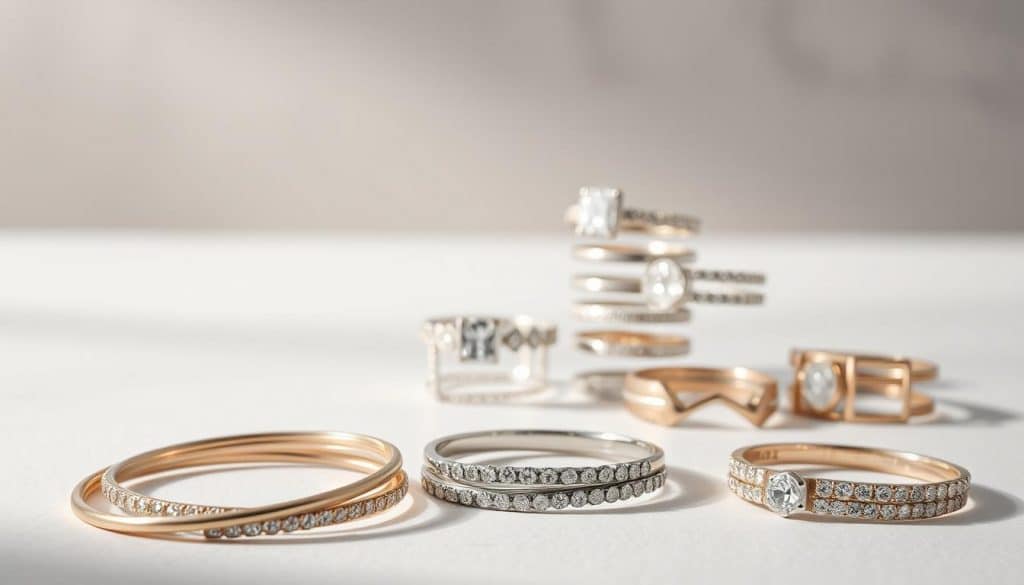
With the right ring stacking techniques, you can create a stylish and cohesive look that’s perfect for any occasion. Ring stacking is all about balance, harmony, and expressing your personal style through the art of layering rings.
Midi Rings and Traditional Rings
Midi rings have gained popularity for their versatility in stacking. These rings are designed to be worn between the knuckle and the tip of the finger, offering a unique way to layer jewelry. When combining midi rings with traditional rings, consider the metal type and design to ensure they complement each other. For instance, pairing a delicate midi ring with a statement traditional ring can create an interesting contrast.
Tips for Mixing Midi and Traditional Rings:
- Start with a simple midi ring and pair it with a more ornate traditional ring.
- Experiment with different metals, like rose gold and silver, to add depth.
- Consider the width of the rings; a thin midi ring can be paired with a wider traditional ring for balance.
Creating Balance Across Multiple Fingers
Balancing rings across multiple fingers is crucial for a polished look. To achieve this, consider the visual weight of the rings and distribute them accordingly. For example, if you’re wearing a bold statement ring on one finger, balance it with simpler rings on adjacent fingers.
Key Considerations for Balance:
- Distribute visual weight evenly across fingers.
- Mix and match ring sizes and styles to create visual interest.
- Avoid over-accessorizing; leave some fingers bare for a cleaner look.
Statement Rings and Supporting Cast
A statement ring can be the centerpiece of your ring stacking look. To make it shine, surround it with a supporting cast of simpler rings that complement its design without overpowering it. This technique not only highlights the statement piece but also adds depth to your overall look.
Tips for Pairing Statement Rings:
- Choose supporting rings that share a common element, like metal type or gemstone color, with the statement ring.
- Vary the size and texture of the supporting rings to add dimension.
- Consider the occasion; for formal events, opt for more luxurious materials and designs.
Knuckle-to-Nail Distribution
The distribution of rings from the knuckle to the nail can significantly impact the overall aesthetic of your ring stacking. A well-placed ring stack can elongate the finger and add visual interest. Experiment with different placements, such as clustering rings at the base of the finger or spacing them out, to find what works best for you.
Experimenting with Ring Placement:
- Try clustering rings at the knuckle for a bold statement.
- Space rings out along the finger for a more subtle look.
- Mix midi rings with traditional rings for a layered effect.
By mastering these ring stacking techniques, you can elevate your jewelry game and create a look that’s uniquely yours. Whether you’re dressing up or dressing down, the art of layering rings offers endless possibilities for self-expression.
Earring Layering: From Subtle to Statement
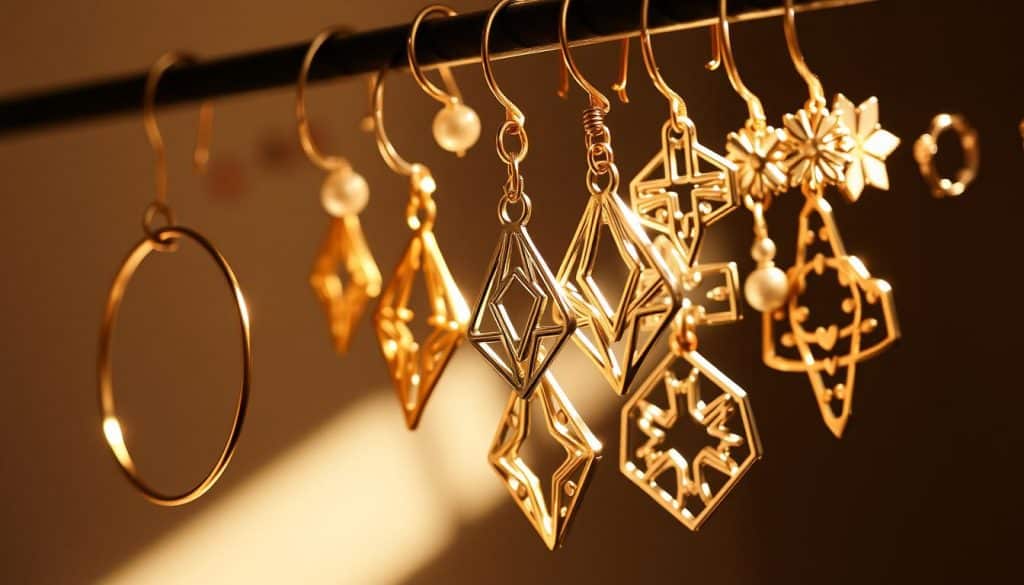
As we explore the world of earring layering, it’s clear that this trend offers endless possibilities for self-expression. Earring layering has become a significant aspect of modern jewelry styling, allowing individuals to showcase their personality and flair through various combinations.
Multiple Piercings Styling Guide
For those with multiple piercings, the key to successful earring layering lies in creating a cohesive look. We recommend starting with a focal point, such as a statement earring, and then balancing it with simpler pieces on other piercings.
- Begin with a bold or eye-catching earring as your centerpiece.
- Complement it with smaller, more delicate earrings on other piercings.
- Experiment with different textures and materials to add depth.
Ear Cuffs and Climbers
Ear cuffs and climbers offer a versatile way to enhance your earring layering. These pieces can add a dramatic touch or subtly fill the space between piercings.
Tips for incorporating ear cuffs and climbers:
- Choose ear cuffs that complement the metal tones of your other earrings.
- Use climbers to create a seamless transition between piercings.
- Mix and match different styles to achieve a unique look.
Balancing Asymmetry
Asymmetry can add visual interest to your earring layering. To balance an asymmetrical look, consider the overall aesthetic you want to achieve.
Strategies for balancing asymmetry include:
- Using a bold piece on one ear and a simpler arrangement on the other.
- Creating a sense of harmony by balancing visual weight.
- Experimenting with different combinations to find what works best for you.
Single vs. Multiple Ear Approaches
Whether to layer earrings on one ear or multiple ears depends on personal preference and the desired impact.
| Approach | Description | Best For |
|---|---|---|
| Single Ear Layering | Focuses on creating a statement on one ear. | Those who want to make a bold statement or have limited piercings. |
| Multiple Ear Layering | Involves layering earrings across multiple ears or piercings. | Individuals with multiple piercings looking for a complex, layered look. |
By understanding these approaches, you can choose the method that best suits your style and preferences.
Layering Jewelry for Beginners: Simple Starting Points
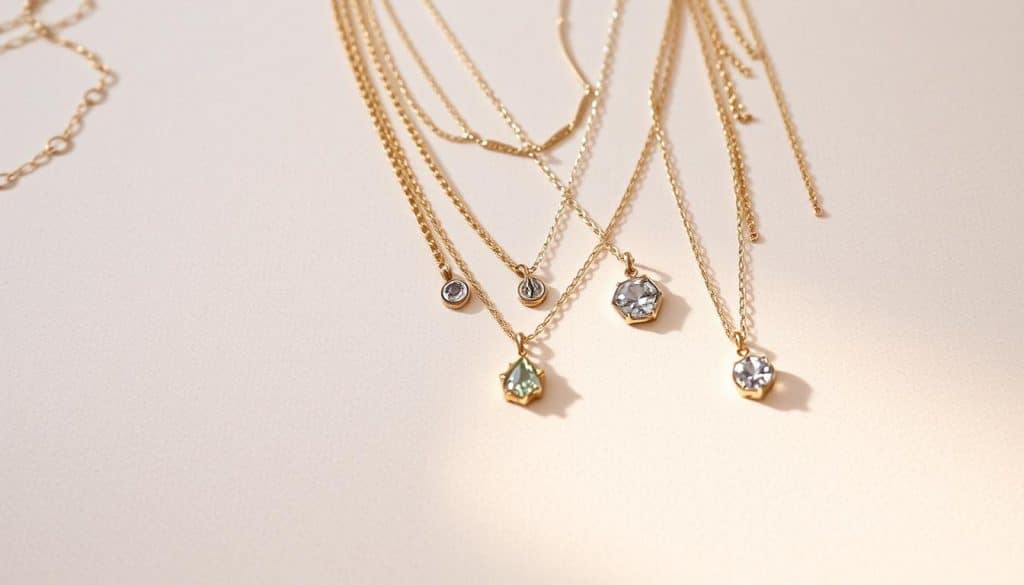
For those new to jewelry layering, the idea of combining multiple pieces can seem daunting, but it’s actually quite straightforward once you understand the basics. We will guide you through simple starting points to help you build your layering skills with confidence.
Three Foolproof Combinations to Try First
To get you started, here are three simple yet stylish combinations:
- A delicate chain necklace paired with a bold pendant
- A stack of thin bangles with a statement cuff
- A midi ring on top of a traditional band on the same finger
These combinations are great for beginners because they offer a mix of textures and visual interest without being overwhelming.
Building Confidence with Pre-Layered Pieces
If you’re just starting out, consider investing in pre-layered pieces. These are items that already have multiple elements combined, such as a necklace with multiple chains or a cuff with integrated bangles.
Pre-layered pieces can help you achieve a layered look instantly, giving you the confidence to experiment further.
Common Mistakes to Avoid
As you begin your layering journey, be aware of a few common pitfalls:
| Mistake | Correction |
|---|---|
| Over-layering | Start with 2-3 pieces and gradually add more |
| Mismatched metals | Choose a dominant metal and complement with others |
| Ignoring proportions | Balance large pieces with smaller, delicate ones |
Gradually Expanding Your Layering Skills
As you become more comfortable with layering, you can start to experiment with different combinations and styles. Try mixing different textures, metals, and lengths to create unique looks.
Remember, the key to successful layering is balance and harmony. Don’t be afraid to try new things and adjust as needed.
Mixing Metals: Breaking Traditional Rules
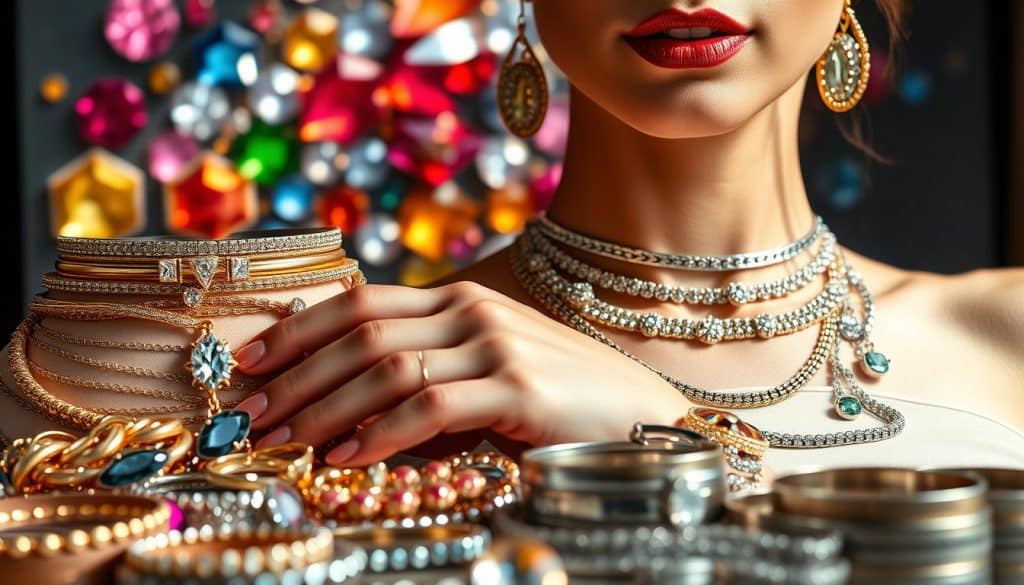
Gone are the days of sticking to a single metal type; mixing metals has emerged as a bold statement in jewelry layering. This trend allows for a more personalized and dynamic approach to styling, enabling individuals to express their unique taste through their jewelry choices.
Combining Gold and Silver
One of the most striking ways to mix metals is by combining gold and silver. This contrast creates visual interest and adds depth to your layered look. To achieve a harmonious balance, consider pairing a gold chain necklace with a silver pendant or stacking gold and silver bangles together.
Incorporating Rose Gold
Rose gold has become increasingly popular, and incorporating it into your metal mix can add a touch of warmth and elegance. Try layering rose gold with white gold or silver for a sophisticated look. Rose gold pairs particularly well with delicate designs and can add a romantic flair to your overall style.
Using Mixed-Metal Pieces as Connectors
Mixed-metal pieces can serve as perfect connectors between different metals, helping to create a cohesive look. For instance, a mixed-metal cuff can bridge the gap between a silver watch and a gold necklace, tying your entire outfit together.
Metal Mixing Ratios for Balance
Achieving balance is key when mixing metals. A general rule of thumb is to maintain a ratio that prevents any one metal from overpowering the others. For example, if you’re layering necklaces, you might choose two silver chains and one gold chain, or vice versa, to create a balanced look.
| Metal Combination | Ratio | Style Outcome |
|---|---|---|
| Gold & Silver | 2:1 | Modern, edgy |
| Rose Gold & White Gold | 1:1 | Elegant, sophisticated |
| Silver & Rose Gold | 3:2 | Warm, eclectic |
By understanding and applying these metal mixing techniques, you can enhance your jewelry stacking and create layered looks that are both stylish and uniquely yours.
Current Layered Jewelry Trends Worth Trying

The art of layering jewelry continues to evolve, with the latest trends highlighting personalized, meaningful, and texture-forward combinations. As we explore these trends, we’ll discover how to incorporate them into our everyday looks.
Minimalist Layering Approaches
Minimalist layering is all about subtlety and elegance. This approach involves combining delicate chains, simple pendants, and understated rings to create a cohesive look. To achieve this style, consider the following:
- Start with a foundation piece, such as a simple necklace or a slim ring.
- Add complementary pieces that are similar in style and scale.
- Mix different metals, like silver and gold, to add depth.
Maximalist Stacking Statements
On the opposite end of the spectrum, maximalist stacking makes a bold statement. This trend involves layering multiple chunky pieces, vibrant colors, and eclectic designs to create a striking look. To master maximalist stacking, try the following:
- Choose a focal point, such as a bold necklace or a statement cuff.
- Build around this piece with other chunky accessories.
- Don’t be afraid to mix different textures and colors.
Personalized and Meaningful Combinations
Personalized jewelry has become increasingly popular, and layering these pieces adds an extra layer of meaning. Consider combining:
- Initial necklaces with birthstone pendants.
- Custom-engraved rings with special messages.
- Family heirlooms with modern pieces.
This trend is all about telling your story through jewelry.
Texture-Forward Layering
Texture plays a crucial role in adding depth to layered jewelry. Mixing different textures can elevate your look and make it more interesting. Try combining:
- Matte and polished finishes.
- Rough, organic textures with smooth, metallic ones.
- Chain belts with fabric or leather accessories.
By incorporating these current layered jewelry trends into your wardrobe, you can refresh your style and stay on top of the latest fashion must-haves.
Layering Jewelry for Different Occasions
Layering jewelry is an art that adapts to every occasion, from casual daily wear to formal events. The key to mastering this art lies in understanding how to adjust your layering technique to suit different settings and events.
Everyday Casual Layering
For everyday casual wear, the focus is on comfort and subtlety. We recommend starting with simple, versatile pieces like a delicate chain necklace paired with a minimalist pendant.
- Mix metals and textures to add depth.
- Keep the color palette neutral.
- Stack bracelets for a relaxed, effortless look.
Office-Appropriate Stacking
In a professional setting, it’s essential to strike a balance between elegance and restraint. Opt for more refined pieces that add sophistication without being too flashy.
- Choose a statement piece, like a bold necklace, as a focal point.
- Pair it with simpler, more understated pieces.
- Consider the office dress code when selecting your jewelry.
Special Event and Evening Looks
For special occasions, you can be more daring and creative with your layering. This is the time to incorporate more luxurious materials and statement pieces.
- Experiment with mixing different chain lengths and textures.
- Add some sparkle with diamonds or crystals.
- Consider the neckline of your outfit when choosing necklaces.
Vacation and Travel-Friendly Combinations
When traveling, it’s practical to wear jewelry that’s both stylish and durable. Opt for pieces that are easy to mix and match.
- Choose versatile, multi-functional pieces.
- Consider the activities you’ll be doing and dress accordingly.
- Pack a few essential pieces that can be layered.
| Occasion | Jewelry Layering Tips |
|---|---|
| Everyday Casual | Mix metals, keep it simple, stack bracelets |
| Office | Choose a statement piece, pair with simple pieces, consider dress code |
| Special Events | Mix chain lengths, add sparkle, consider outfit neckline |
| Vacation/Travel | Choose versatile pieces, consider activities, pack essentials |
Troubleshooting Common Layering Challenges
The art of layering jewelry is not without its challenges, but understanding how to overcome them can elevate your style. As we delve into the world of jewelry stacking, we’ll address some of the most common issues you might encounter and provide practical solutions to make your layering experience seamless.
Dealing with Tangled Necklaces
Tangled necklaces are a common frustration when layering jewelry. To prevent this, we recommend starting with necklaces of different lengths to minimize overlap. When layering necklaces of similar lengths, use a chain separator or a small clasp to keep them apart. For persistent tangles, try laying your necklaces flat on a surface and gently working out the knots.
Preventing Skin Irritation
Skin irritation can occur when different metals or materials come into contact with your skin, especially if you’re layering multiple pieces. To prevent this, choose jewelry made from hypoallergenic materials like surgical stainless steel, titanium, or solid gold. If you’re sensitive to certain metals, consider using a barrier like clear nail polish on the irritating surface.
Adjusting for Comfort Throughout the Day
Comfort is key when layering jewelry. To ensure your layered pieces remain comfortable throughout the day, adjust the clasp to a comfortable tightness and consider the weight distribution of your jewelry. If you’re wearing heavy pieces, you might need to make adjustments during the day to maintain comfort.
Storage Solutions for Layered Sets
Proper storage is crucial for maintaining your layered jewelry sets. Use a jewelry organizer with separate compartments to store each piece, preventing tangles and scratches. For delicate or intricate pieces, consider storing them in soft pouches or wrapping them individually to protect them.
By addressing these common challenges, you can enjoy a more streamlined and enjoyable jewelry layering experience. Whether you’re a seasoned jewelry enthusiast or just starting to explore the world of layering, these tips will help you create beautiful, comfortable looks that showcase your personal style.
Conclusion: Developing Your Personal Layering Style
As we conclude our comprehensive guide on jewelry layering, we encourage you to experiment and develop your personal layering style. By applying the techniques and tips outlined in this article, you’ll be well on your way to mastering the art of layering jewelry.
To refresh, we’ve covered the essential jewelry pieces, proportions, and balance required for successful layering. We’ve also explored various layering techniques, including necklace layering, bracelet stacking, and ring stacking. For those new to layering, our jewelry layering tips for beginners provide a solid foundation to build upon.
When learning how to layer jewelry, it’s essential to remember that practice makes perfect. Don’t be discouraged if it takes time to find your unique style. Continue to experiment with different combinations, and you’ll soon discover what works best for you.
By incorporating jewelry layering into your daily routine, you’ll not only elevate your personal style but also develop a more nuanced understanding of what complements your features and wardrobe. We hope this guide has inspired you to continue exploring the world of layered jewelry and to develop a style that’s truly yours.
FAQ
What is jewelry layering, and why is it important?
Jewelry layering is the practice of wearing multiple pieces of jewelry together to create a unique and stylish look. It’s essential in current fashion trends as it allows individuals to express their personal style, creating visual interest and dimension.
How do I start layering jewelry if I’m a beginner?
To start layering jewelry, begin with simple combinations, such as pairing a delicate necklace with a bold pendant or stacking bangles with a cuff. Experiment with different textures, metals, and lengths to create a look that’s uniquely yours.
What are the essential pieces for successful jewelry layering?
Foundation pieces like a simple chain necklace, a pair of stud earrings, and a delicate ring are must-haves for layering. You can also incorporate statement pieces, like bold pendants or chunky cuffs, to add visual interest.
How do I mix and match different metals when layering jewelry?
Mixing metals is a great way to add depth to your layered look. Start by combining two metals, like gold and silver, and balance them with a mixed-metal piece or a neutral metal like rose gold.
What are some common mistakes to avoid when layering jewelry?
Common mistakes include over-accessorizing, which can make your look feel cluttered, and not considering the occasion or your personal style. Also, be mindful of tangles, knots, and skin irritation when layering necklaces and bracelets.
How can I prevent tangles and knots when layering necklaces?
To prevent tangles, layer necklaces of different lengths, use a necklace separator or a clasp with a built-in separator, and store your necklaces separately when not in use.
Can I layer jewelry for different occasions, like work or a special event?
Absolutely! Layering jewelry can be adapted to suit various occasions. For work, opt for more understated pieces, while for a special event, you can go bolder with statement pieces.
How do I care for my layered jewelry to ensure it remains in good condition?
To keep your layered jewelry in good condition, store pieces separately, avoid exposing them to harsh chemicals, and clean them regularly with a soft cloth.
What are the current trends in layered jewelry that I should try?
Current trends include minimalist layering approaches, maximalist stacking statements, personalized and meaningful combinations, and texture-forward layering. Experiment with these trends to find what works best for you.
share this recipe:
Still hungry? Here’s more

Gold Filled vs Vermeil Guide Differences Durability and Value
What Is Gold Filled Jewelry? Gold filled jewelry is my go-to recommendation when someone wants

How Much for a Gold Necklace 2026 Price Guide and Tips
Understanding Gold Purity and Karats When people ask “how much for a gold necklace?”, the

Spiritual Jewelry Symbols Guide- Meanings and How to Choose
How to Use This Spiritual Jewelry Symbols Guide Spiritual jewelry only works for you when
Ready to Design Your Own Jewelry?
Have an idea in mind or need help shaping it? From sketches to finished pieces, our custom jewelry team will work with you step-by-step to bring your vision to life.
